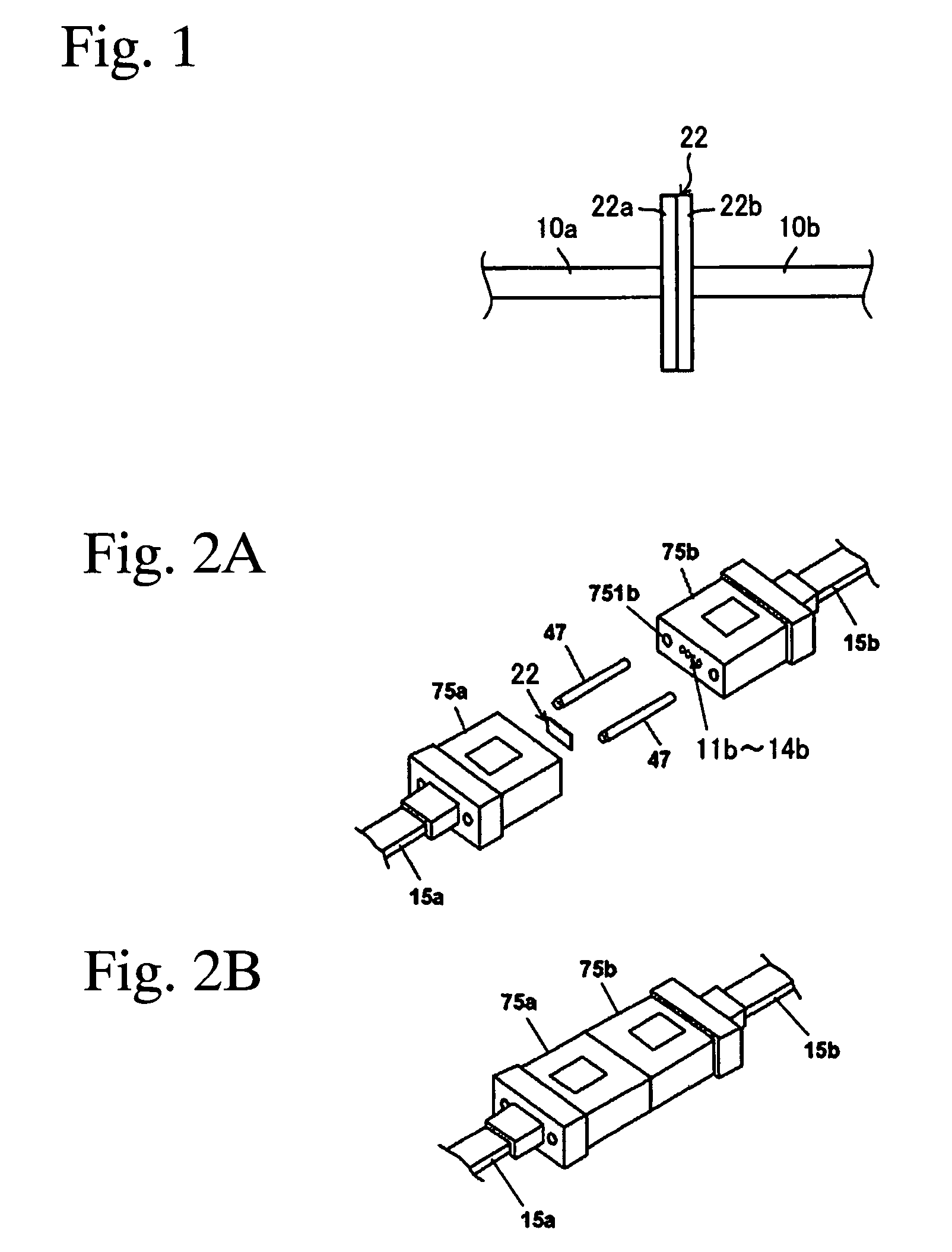Adhesive connecting member, optical connecting structure used therewith, and jig for attaching adhesive connecting member
a technology of optical connection and adhesive, which is applied in the direction of photosensitive materials, instruments, transportation and packaging, etc., can solve the problems of increasing the cost of connecting optical fiber, difficult re-attempt of connection, and greatly affecting the transmission efficiency of optical transmission path using optical fiber. , to achieve the effect of facilitating handling, reducing the loss of connection, and convenient optical connection
- Summary
- Abstract
- Description
- Claims
- Application Information
AI Technical Summary
Benefits of technology
Problems solved by technology
Method used
Image
Examples
first embodiment
(1) First Embodiment
[0035]The adhesive connecting member of the present invention optically connects an optical transmission medium such as an optical fiber or optical part (a) and another optical transmission medium or optical part (b) by being intervened therebetween, and the member has a strongly adhesive face and a weakly adhesive face.
[0036]The first embodiment is explained with reference to FIG. 1.
[0037]FIG. 1 is a side view showing the optical connecting structure of the first embodiment in which the adhesive connecting member of the present invention is used.
[0038]Reference numerals 10a and 10b correspond to optical fibers, reference numeral 22 corresponds to a sheet-shaped adhesive connecting member, reference numeral 22a corresponds to a strongly adhesive face, and reference numeral 22b corresponds to a weakly adhesive face.
[0039]The sheet-shaped adhesive connecting member 22 has the strongly adhesive face 22a and the weakly adhesive face 22b. It is possible that the stron...
second embodiment
(2) Second Embodiment
[0074]Next, the second embodiment is explained with reference to FIGS. 2 and 3.
[0075]FIG. 2 is a perspective view showing the optical connecting structure of the second embodiment using the adhesive connecting member of the present invention.
[0076]Reference numerals 11a to 14a and 11b to 14b correspond to optical fibers, reference numerals 15a and 15b correspond to an optical fiber tape core wire having four cores, reference numeral 47 corresponds to a guide pin, reference numerals 75a and 75b correspond to MT connectors, and reference numerals 751a and 751b correspond to insertion holes for guide pins.
[0077]In FIG. 2, the sheet-shaped adhesive connecting member 22 intervenes between the connection end surfaces of the MT connectors 75a and 75b.
[0078]As shown in FIG. 2A, the two MT connectors 75a and 75b are aligned by the guide pin 47 and face each other via the sheet-shaped adhesive connecting member 22. Thus, the optical fibers are optically connected as show...
third embodiment
(1) Third Embodiment
[0095]The jig for attaching the adhesive connecting member of the third embodiment of the present invention is explained with reference to FIGS. 4 and 5.
[0096]FIG. 4 is a diagram showing the jig for attaching the adhesive connecting member of the third embodiment of the present invention, FIG. 4A is a plane view, FIG. 4B is a cross sectional view along the line B-B, FIG. 4C is a perspective view, and FIG. 5 is a magnified cross sectional view along the line A-A.
[0097]Reference numeral 30 corresponds to a tabular member which forms the jig for attaching the adhesive connecting member of the third embodiment, reference numeral 31 corresponds to an adhesive connecting member, reference numeral 31a corresponds to a strongly adhesive layer, reference numeral 31b corresponds to a weakly adhesive layer, reference numeral 32 corresponds to a board having holes which forms the tabular member, reference numeral 33 corresponds to a substrate board which forms the tabular me...
PUM
| Property | Measurement | Unit |
|---|---|---|
| refractive index | aaaaa | aaaaa |
| optical transmittance | aaaaa | aaaaa |
| optical transmittance | aaaaa | aaaaa |
Abstract
Description
Claims
Application Information
 Login to View More
Login to View More - R&D
- Intellectual Property
- Life Sciences
- Materials
- Tech Scout
- Unparalleled Data Quality
- Higher Quality Content
- 60% Fewer Hallucinations
Browse by: Latest US Patents, China's latest patents, Technical Efficacy Thesaurus, Application Domain, Technology Topic, Popular Technical Reports.
© 2025 PatSnap. All rights reserved.Legal|Privacy policy|Modern Slavery Act Transparency Statement|Sitemap|About US| Contact US: help@patsnap.com



